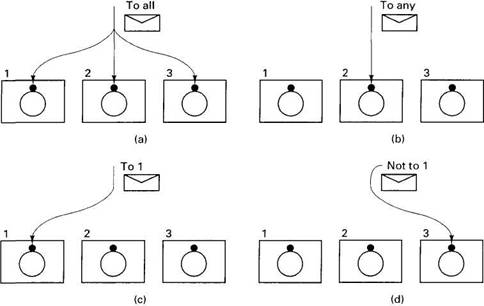Книга: Distributed operating systems
9.4.3. Communication Operations
9.4.3. Communication Operations
Two kinds of communication operations are provided by Chorus: asynchronous send and RPC. Asynchronous send allows a thread simply to send a message to a port. There is no guarantee that the message arrives and no notification if something goes wrong. This is the purest form of datagram and allows users to build arbitrary communication patterns on top of it.
The other communication operation is RPC. When a process performs an RPC operation, it is blocked automatically until either the reply comes in or the RPC timer expires, at which time the sender is unblocked. The message that unblocks the sender is guaranteed to be the response to the request. Any message that does not bear the RPC's transaction identifier will be stored in the port for future consumption but will not awaken the sender.
RPCs use at-most-once semantics, meaning that in the event of an unrecoverable communication or processing failure, the system guarantees that an RPC will return an error code rather than take a chance on having an operation executed more than once.
It is also possible to send a message to a port group. Various options are available, as shown in Fig. 9-16. These options determine how many messages are sent and to which ports.

Fig. 9-16. Options for sending to a port group. (a) Send to all members. (b) Send to any member. (c) Send to port at the same site as a given port. (d) Send to a port not at a specific site.
Option (a) in Fig. 9-16 sends the message to all ports in the group. For highly reliable storage, a process might want to have every file server store certain data. Option (b) sends it to just one, but lets the system choose which one. When a process just wants some service, such as the current date, but does not care where it comes from, this option is the best choice, as the system can then select the most efficient way to provide the service.
The other two options also send to just one port, but limit the choice the system may make. In (c), the caller can specify that the port must be on a specific site, for example, to balance the system load. Option (d) says that any port not on the specified site may be used. A use for this option might be to force a backup copy of a file onto a different machine than the primary copy.
Sends to port groups use the asynchronous send. Broadcast sends (i.e., to all members) are not flow controlled. If flow control is required, it must be supplied by the user.
To receive a message, a thread makes a kernel call telling which port it wants to receive on. If a message is available, the fixed part of the message is copied to the caller's address space, and the body, if any, is either copied or mapped in, depending on the options. If no message is available, the calling thread is suspended until a message arrives or a user-specified timer expires.
Furthermore, a process can specify that it wants to receive from one of the ports it owns, but it does not care which one. This option can be further refined by disabling some of the ports, in which case only enabled ports are eligible to satisfy the request. Finally, ports can be assigned priorities, which means that if more than one enabled port has a message, the enabled port with the highest priority will be selected. Ports can be enabled and disabled dynamically, and their priorities can be changed at will.
- Generalized identity operations
- Heap operations
- Arithmetic operations
- Logical operations
- 8.5.2 Typical Condition Variable Operations
- Integrated Secure Communications System
- 11.7 Soft Timers and Timer Related Operations
- The Impossibility of Communication
- 7.3.3. Network Operations
- 8.3.1. Driver File System Operations
- PROJECT 6.10 — Serial Communication–Based Calculator
- Using Software-Based Serial Communication




